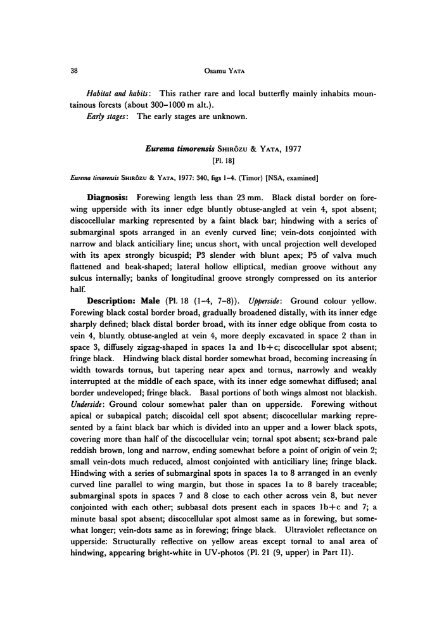A Revision of the Old World Species (Lepidoptera, Pieridae)
A Revision of the Old World Species (Lepidoptera, Pieridae)
A Revision of the Old World Species (Lepidoptera, Pieridae)
You also want an ePaper? Increase the reach of your titles
YUMPU automatically turns print PDFs into web optimized ePapers that Google loves.
38 Osamu Yata<br />
Habitat and habits: This ra<strong>the</strong>r rare and local butterfly mainly inhabits moun<br />
tainous forests (about 300-1000 m alt.).<br />
Earlystages: The early stages are unknown.<br />
Eurema timorensis Shirozu & Yata, 1977<br />
[PI. 18]<br />
Eurema timorensis Shir6zu & Yata, 1977: 340, figs 1-4. (Timor) [NSA, examined]<br />
Diagnosis: Forewing length less than 23 mm. Black distal border on fore<br />
wing upperside with its inner edge bluntly obtuse-angled at vein 4, spot absent;<br />
discocellular marking represented by a faint black bar; hindwing with a series <strong>of</strong><br />
submarginal spots arranged in an evenly curved line; vein-dots conjointed with<br />
narrow and black anticiliary line; uncus short, with uncal projection well developed<br />
with its apex strongly bicuspid; P3 slender with blunt apex; P5 <strong>of</strong> valva much<br />
flattened and beak-shaped; lateral hollow elliptical, median groove without any<br />
sulcus internally; banks <strong>of</strong> longitudinal groove strongly compressed on its anterior<br />
half.<br />
Description: Male (PI. 18 (1-4, 7-8)). Upperside: Ground colour yellow.<br />
Forewing black costal border broad, gradually broadened distally, with its inner edge<br />
sharply defined; black distal border broad, with its inner edge oblique from costa to<br />
vein 4, bluntly, obtuse-angled at vein 4, more deeply excavated in space 2 than in<br />
space 3, diffusely zigzag-shaped in spaces la and lb+c; discocellular spot absent;<br />
fringe black. Hindwing black distal border somewhat broad, becoming increasing in<br />
width towards tornus, but tapering near apex and tornus, narrowly and weakly<br />
interrupted at <strong>the</strong> middle <strong>of</strong> each space, with its inner edge somewhat diffused; anal<br />
border undeveloped; fringe black. Basal portions <strong>of</strong> both wings almost not blackish.<br />
Underside: Ground colour somewhat paler than on upperside. Forewing without<br />
apical or subapical patch; discoidal cell spot absent; discocellular marking repre<br />
sented by a faint black bar which is divided into an upper and a lower black spots,<br />
covering more than half <strong>of</strong> <strong>the</strong> discocellular vein; tornal spot absent; sex-brand pale<br />
reddish brown, long and narrow, ending somewhat before a point <strong>of</strong>origin <strong>of</strong> vein 2;<br />
small vein-dots much reduced, almost conjointed with anticiliary line; fringe black.<br />
Hindwing with a series <strong>of</strong> submarginal spots in spaces la to 8 arranged in an evenly<br />
curved line parallel to wing margin, but those in spaces la to 8 barely traceable;<br />
submarginal spots in spaces 7 and 8 close to each o<strong>the</strong>r across vein 8, but never<br />
conjointed with each o<strong>the</strong>r; subbasal dots present each in spaces lb+c and 7; a<br />
minute basal spot absent; discocellular spot almost same as in forewing, but some<br />
what longer; vein-dots same as in forewing; fringe black. Ultraviolet reflectance on<br />
upperside: Structurally reflective on yellow areas except tornal to anal area <strong>of</strong><br />
hindwing, appearing bright-white in UV-photos (PI. 21 (9, upper) in Part II).
















